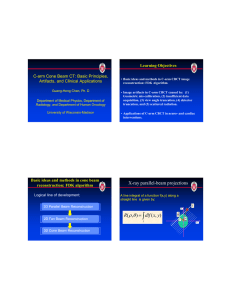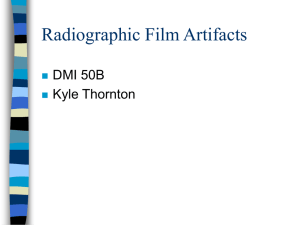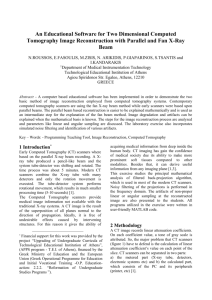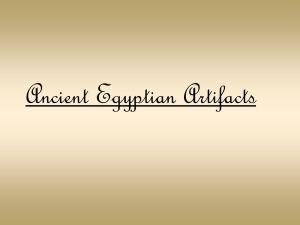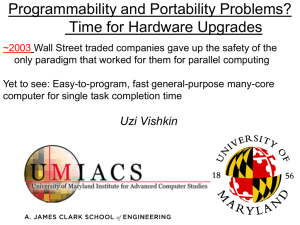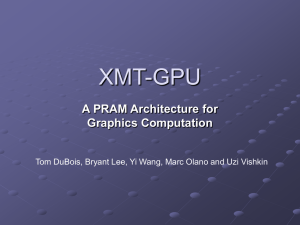xmt
advertisement
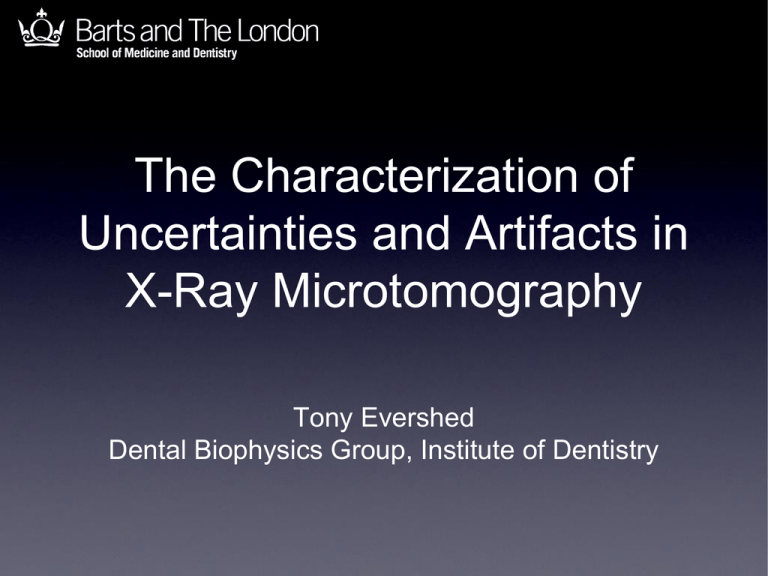
The Characterization of Uncertainties and Artifacts in X-Ray Microtomography Tony Evershed Dental Biophysics Group, Institute of Dentistry What is XMT? • • • • Tomography, from Greek tomos (‘section’) and graphos (‘to write’). 2-3D representation based on a large number of projections. Tens-of-microns spatial resolution. Attenuation coefficient resolution sufficient for mineral-content analysis. XMT at QMUL • • • MuCAT Systems 1 and 2. Cone-beam XMT with time-delay integrating detectors. Based on COTS infrastructure with in-house software and detector hardware. Cone Beam Tomography Image: Wikipedia (released into Public Domain) Cone Beam Tomography Image: Wikipedia (released into Public Domain) QMT at QMUL - TDI • • • Means of averaging pixel sensitivity. Charge-coupled devices move charge in ‘steps’ by switching voltage at each pixel. Synchronization of step frequency to sample movement. Animation: Michael Schmidt (released under GFDL.) Applications of XMT Video: Dr G R Davis Examining decayed or damaged scrolls. Applications of XMT Image: F Ahmed Analysis of biomaterial and artificial structures. Applications of XMT Video: Dr G R Davis Mineralization studies in hard tissue. Sources of Artifacts • • Geometrical artifacts • • Centre-of-rotation errors. Specimen motion errors. Focus: grayscale artifacts. • • Beam Hardening Scattering. Artifacts: Beam Hardening • Arises from use of polychromatic radiation. • Materials do not follow Beer’s law: I = I0 e-μx. • Materials absorb ‘soft’ X-rays preferentially. • Beam becomes ‘harder’ and more penetrating. Image: Dr G R Davis Observed LAC Artifacts: Beam Hardening • ‘Cupping’ artifact from beam hardening. Artifacts: Beam Hardening • Correction: compare ideal Beer-law case with a known material added to the sample. • Multi-mode samples complicate matters. Image: Dr G R Davis Artifacts: Scatter • Instead of being absorbed, photons may be deflected. • • • Compton (incoherent) scattering, from outer electron shells, largely responsible. Increases level of noise in the reconstruction, particularly near high-attenuation regions. Decreases contrast ratio in the reconstruction. Artifacts: Scatter • • • Correction: none at present at QMUL. • Beam-hardening correction also corrects for some scatter. Level of scatter can be determined from projection borders (outside cone beam.) Monte Carlo modelling of virtual phantoms using Geant4 transport code. Conclusion: Research Outcomes for QMUL • • Reconstruction developments fed into existing MuCAT systems. MuCAT 3 next-generation scanner. • • • Improved spatial resolution. Larger sample capacity. In tender, for delivery during 2012. Acknowledgements • • • Supervisors: • • Dr Graham Davis (Institute of Dentistry) Dr Andrea Cavallaro (School of Electronic Engineering and Computer Science). Post-doc: • Dr David Mills. Engineering and Physical Sciences Research Council grant EP/G007845/1.



